#Jabłonna palace
Text
Józef Poniatowski’s women.
Part V. The rest of ladies who might have been of some interest to him
Good day everyone and let me share with the rest of information I possess on Prince Poniatowski's love interests. (Though, I have to admit, the ladies from this list were the least likely - from all the mentioned in these series of post - to have some kind of affair with Pepi.
To start I would like by Louise of Mecklenburg-Strelitz, the queen of Prussia.
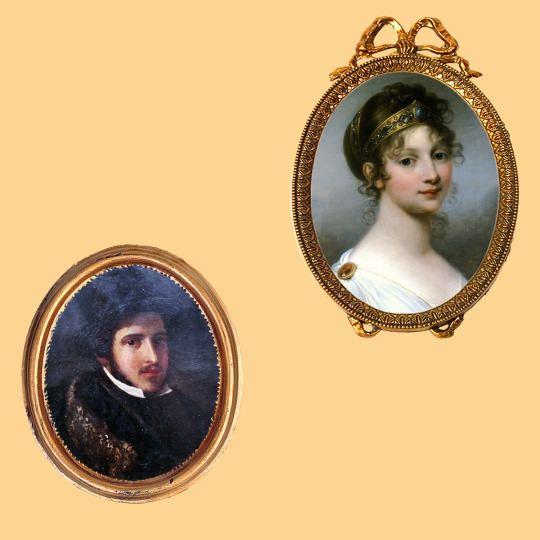
On the right - unidentified artist, miniature portrait of Prince Poniatowski, 19th century. On the left - portrait of Queen Louise by Giuseppe Grassi, 1802.
Prince Józef had the opportunity to meet the wife of the king Frederick William III at least four times, because the royal couple visited Warsaw - which had become a part of Prussia as a result of the third partition of Poland - three times, in 1798, 1802 and 1805. And in 1802 Poniatowski himself had to go to Berlin, to settle the matter of the inheritance left by his uncle Stanisław August.
According to Juliusz Fałkowski, while at Warsaw Prince Józef "…gave a ball and a dinner in the Copper-Roof palace in their honor [the King and Queen of Prussia - A.S.] and was flirting with the Queen everywhere", for which he received the star of the black eagle, although he rather "expected something else from the beautiful queen." After the departure of the royal couple, "he longed a little for the crowned beauty who had easily won his heart in passing."
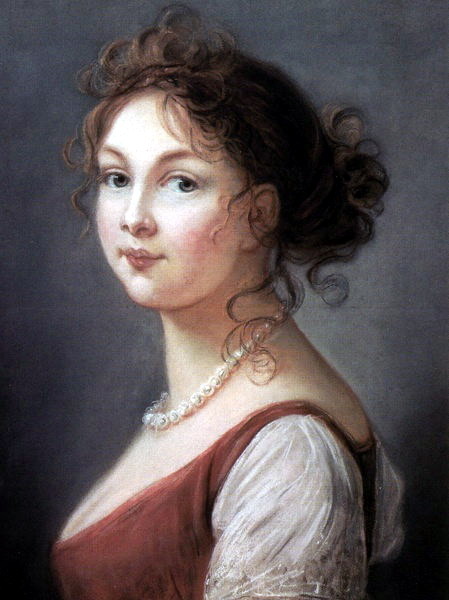
An Elisabeth Vigée-Lebrun painting of Queen Louise, c. 1801
The second source that mentions the relationship between these two is the book by Marian Brandys "Kozietulski i inni", which states (without giving sources, unfortunately) that during Pepi's visit to the capital of Prussia "… it was also said that the beautiful Queen Louise fell in love with in a knightly Pole."
However, if you ask my opinion about the likelihood of an affair between Pepi and the Queen of Prussia, I will say that in my opinion he was "flirting" her to make it easier to solve the inheritance problem. As for the fact that she could also be in love with the prince, I have no opinion because my knowledge about Queen Louise is not very great.
The second lady in today's list will be prince Józef's first cousin once removed, Anetka Potocka (née Tyszkiewicz, the daughter of Konstancja Poniatowska and a grand-daughter of prince Kazimierz, the oldest of the Poniatowski siblings).

On the left - Poniatowski's portrait by Franciszek Paderewski, on the right - Portrait of Anetka Tyszkiewiczówna, Giuseppe Grassi, 1796.
Born in 1779, she was 16 years younger than Pepi, and she remained unmarried for quite a long time, becoming the wife of the Count Aleksander Potocki in 1805. (Marian Brandys, in the biography of Anetka's uncle prince Stanisław, states that some time before 1791 there was an idea to join all the Poniatowski estates marring Stanisław to his niece, but it was eventually abandoned.) The marriage brought them three children, but after 16 years Anetka asked for divorce and then wedded Colonel Stanisław Dunin-Wąsowicz.
During the times of the Duchy of Warsaw, she was a frequent guest at the Copper Roof Palace, visited Paris, witnessed Napoleon's sojourns in Warsaw, with all of those events been described later in her memoirs.
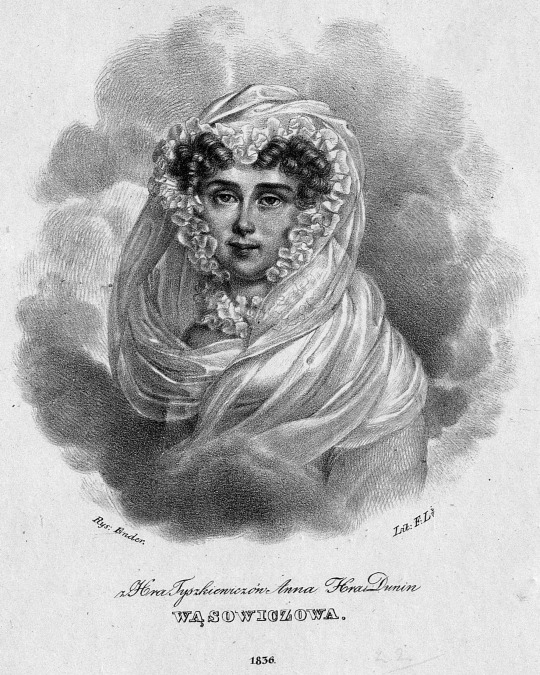
Portrait of Countess Dunin Wąsowicz, Anna née Tyszkiewicz, 1836.
As for her relationship with Prince Józef, it were her own words that made Fałkowski write that "the beautiful prince fell in love with Anetka" although "it was a platonic feeling".
"… Mrs. Aleksandrowa (Anetka Potocka - AS ) herself half-admitted thisin her old age. ''On disait alors que le Prince Joseph avait pour moi un sentiment plus tendre que l'amitié (it was said that Prince Joseph had for me a feeling more tender than friendship),' she would recalled with a dreamy expression on her face."
The second thing that leads historians to believe that Pepi could have distinguished this cousin of his from other relatives is the provision in his will, according to which she was to receive, after the death of the prince's sister, Teresa Tyszkiewicz, his favorite palace in Jabłonna near Warsaw. And when this did happen, Anetka ordered a triumphal arch to be built in the park in memory of Prince Józef.

The palace in Jabłonna, 2019
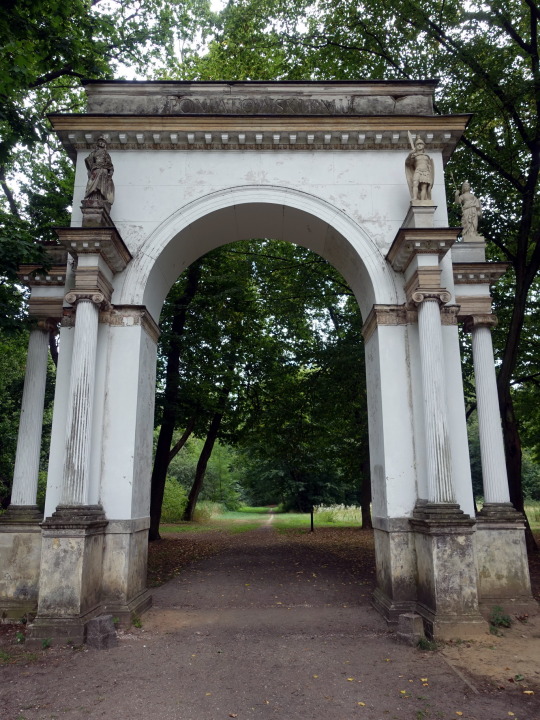
The triumphal arch from Jabłonna's park, 2019
And collage of mine is an illustration to the part dedicated to the rest of the women, whose portraits I wasn't able find. And honestly, the evidence that they might have been Prince Józef's love interests is very weak. But, since historians from time to time do mention these ladies' names, I thought them worth being included as well…
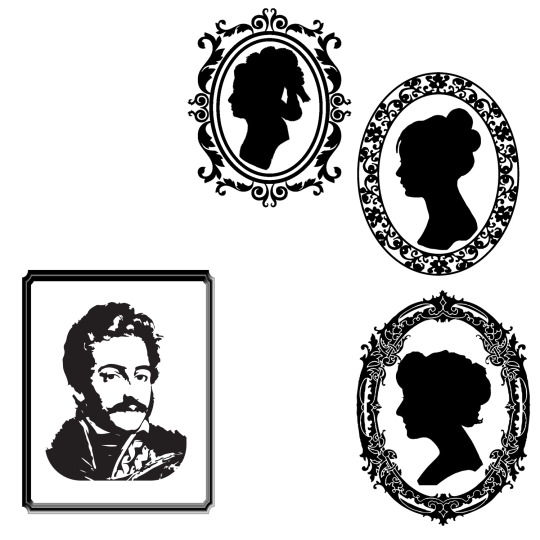
For example, in the prince's testament, together with Henriette de Vauban, Zofia Czosnowska and the above mentioned Anetka Potocka, there was mentioned Elżbieta Merlini, the daughter of Dominique Merlini, an Italian architect, the last main builder of the Polish-Lithuanian Commonwealth. But such concern for the architect's daughter may have been explained by a sense of moral debt to her father, which the prince Józef inherited from King Stanisław with the rest of the things.
Then, the list of Pepi's women sometimes complemented by another "Elżbieta" - Cichocka (although her real names were Emilia Karolina - or Katarzyna) née Bachmińska I° voto Szymanowska, II° voto Cichocka, III° voto Abramowiczowa. It is said she even sojourned in Jabłonna before 1810, until being apparently forced by Zofia Czosnowska to leave the place. After that Madame Cichocka went to Vilna, where she married her third husband. However, what IMHO should be taken into account in regards with this lady is that her second husband, Michał Cichocki, was an illegitimate son of Stanisław August, which might have made Prince Józef consider her a relative and thus take care about.
The same can be said about Madame Kicka - Józefa Martyna Rozalia née Szydłowska, who was a sister of Elżbieta Grabowska, another mistress of King Stanisław.
Sometimes the names of women who were friends and companions of Madame de Vauban are also included to the list of prince Józef's love interests. Those are: Anna Krasińska, a relative of general Krasiński and the wife of Mikołaj Oppeln-Bronikowski; Salomea Wielhorska née Dembińska; Anna Trębicka née Czerska, future wife of general Kamieniecki, and Józefa Potocka née Sollohub.
PS. As the regular visitors to the Copper Roof Palace are as well mentioned two ladies of the surname Walewska: Józefina née Lubomirska, the wife of Adam Walewski and the future wife General Witt, and Maria, the wife of Anastazy Walewski. The first of them was known for her kind of loose behavior, so presumably she might have at least flirted with Pepi; the second one is the famous Maria Walewska, but all I know about her makes me think her love for the emperor left no room in her heart for other men.
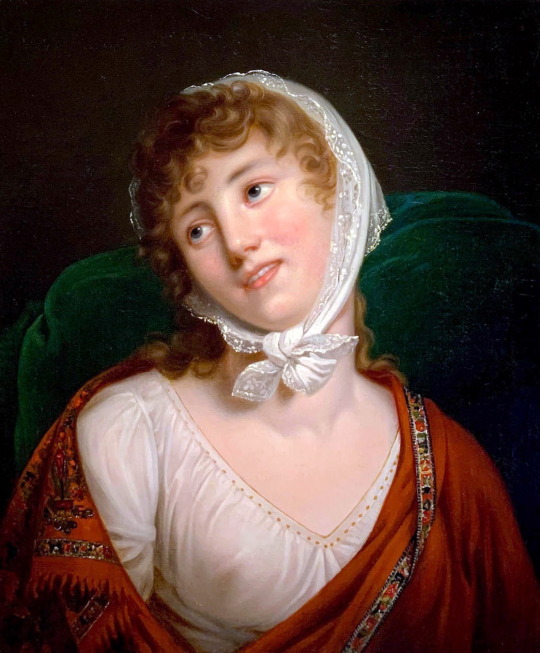
Portrait of Maria Walewska by Robert Lefèvre
#poniatowski#józef poniatowski#józef poniatowski’s women#queen Louise of Prussia#Giuseppe Grassi#Anetka Potocka#Jabłonna#Jabłonna palace#Maria Walewska#Robert Lefèvre
13 notes
·
View notes
Photo

Pałac Poniatowskich w Jabłonnej (1918-1939).
55 notes
·
View notes
Photo

0365.1 -- .2, 2020-01-05 16:14 -- 16:18, Apple iPhone 7, Apple iPhone 7 built-in back wide lens, iOS stock camera app, ..JPEG, Adobe LightRoom, InstaSize, Shot on-the-go, Observed scene (at Jabłonna Palace) https://www.instagram.com/p/CZFlGscIrMS/?utm_medium=tumblr
0 notes
Photo

w: Jabłonna Palace https://www.instagram.com/p/CBlv_7BngKF5YzjsCVUHl1KaspNBVg2g_bYtJ80/?igshid=15bxry0vloimb
0 notes
Photo

Kocham jazdę na rowerze 😍 #jabłonna #jablonnapalace #warsaw #warsawboy #warsawgay #warsawbike #bike #bikeboy #bikestagram #bikeguy #bikegay #gay #gayboy #gaymen #gaystagram #instagay #beardedgay #beardedmen #beardedboy #bearded #loveday #goodday #goodtime #instaday #instaphoto #iphone7 #iphonephotography #iphonegram (w: Jabłonna Palace)
#loveday#gaystagram#gay#beardedboy#bike#goodtime#warsawbike#iphonegram#bikestagram#bearded#warsawgay#jabłonna#warsawboy#goodday#instaphoto#gayboy#gaymen#bikeguy#instaday#iphone7#bikeboy#beardedgay#jablonnapalace#beardedmen#warsaw#instagay#iphonephotography#bikegay
0 notes
Photo

#backstage lately #commercial #shoot with #misspolonia @izabellakrzan #makeupartist #work #makeup #behindthescenes #model #photoshoot #ilovemyjob #mua #hairstyle #makeup #instamakeup #motd #makijaz #Warsaw #fashion #moda #lookoftheday #fashioninspiration #lookbook #clothes #inspo #look #ootd #outfit #outfitoftheday (w: Jabłonna Palace)
#mua#ootd#ilovemyjob#fashion#behindthescenes#outfit#makijaz#hairstyle#shoot#inspo#lookbook#fashioninspiration#lookoftheday#photoshoot#commercial#work#look#warsaw#outfitoftheday#misspolonia#motd#moda#model#makeupartist#backstage#makeup#clothes#instamakeup
0 notes
Photo

Jabłonna Palace - architect Domenico Merlini, Jabłonna, Poland (by nomaderro)
#architecture#neoclassical architecture#neoclassicism#Jabłonna Palace#art history#Domenico Merlini#Jabłonna#Poland#europe#european architecture#polish architecture#polish neoclassicism#neoclassical
21 notes
·
View notes
Text
Answers to the “Favourite Historical Figure: Ask Game”
About prince Józef Poniatowski, of course ;)
Because @josefavomjaaga and @tairin asked me kinda similar questions (4, 6 and 10 and 6 and 15) I decided to answer to both in one post.
And because I am a “perfectionist” and I like to illustrate my posts with images, it took me some time to prepare everything, that is why I am answering only now.
As for illustrations chosen - this time all of them are made by the Polish painter Bronisław Gembarzewski.
4. In your eyes, what is their biggest strength?
A little bit difficult question to answer, I have to admit. Because nowadays prince Józef is usually liked for his patriotism, and his contemporaries noted in him such virtues as kindness and braveness. (And for this he was especially loved by him inferiors - by soldiers.)
The feature of prince Józef’s character which, however, appeal to me most of all is his self-criticism. Because - judging by the correspondence, memoires about him etc which was left - if Poniatowski didn’t know something he would openly admit it. And never was prince Poniatowski arrogant, at meetings of the Council of Ministers, as Kajetan Koźmian recalled, when asked for opinion, he almost always started with these words: "I in my stupid sense think...", though the things with which prince Józef proceeded then were usually precise and clear.

Prince Józef’s in his study in Jabłonna palace.
6. In your opinion, what is their biggest flaw?
Oh, this one will be a little bit easy to answer. In his lifetime, especially before 1809, prince Józef was often accused of being too frivolous, of leading a life too merry, but from my point of view this is a kind of “features”, not flaws.
What really, in my opinion, might have bad influence on his life is that he, being a military commander, was often too indulgent towards those inferiors of him with whom he was in good terms. Remember, in one of the previous posts I wrote that after creation of the Duchy of Warsaw a lot of youth from the “Blacha’s people” joined the Army? Thus automatically becoming Poniatowski’s subordinates. And he continued with them like nothing happened, like the were still only friends of him. (In the case, for example, of jumping naked around the fire in 1809, about which general Fiszer complained, no one, in fact, was punished.)

Infantry regiment review in the courtyard of the palace "Pod Blachą".
10. What is your favourite quote by / about them?
Oh, to this one it will also be interesting to answer. The first phrase, which can into my mind, was Napoleon’s sentence from Saint-Helene, that “Poniatowski was the man which should have been made the king of Poland”. But knowing prince Józef’s reluctance this is not the case.
The second variant was a phrase attributed to him, supposedly pronounced just before his death: “God has entrusted me with the honor of the Poles, to him only I will only give it” (”Bóg mi powierzył honor Polaków, Bogu go tylko oddam”). But modern historians have a lot of doubts whether Poniatowski in fact said something like this, so this looks like to be a legend.
But there is another phrase, also attributed to prince Józef at Leipzig, it is shorter and it sounds much more probable - “Il faut mourir en brave” (We must die brave, one must die brave), and this is the quote I like most all.

The death of prince Józef in the battle of Nation at Leipzig
15. Describe them in one sentence
This, finally, will be very easy, because this kind of “slogan” came into my mind a couple of month ago, during a chat with one of my virtual friends, and is stuck there since then. “He wasn’t quick at setting his mind, but having set was faithful till the end.” Or just “faithful till the end”.

Prince Joseph gives the order to attack in the battle of Raszyn
And thanks a lot for asking!
#Poniatowski#józef poniatowski#bronisław gembarzewski#Battle of Raszyn#Battle of Leipzig#Jabłonna palace
30 notes
·
View notes
Text
Sculptural portraits of prince Józef Poniatowski
Good day to you, dear friends, and let me present you the long postponed post about the sculptural portraits of prince Józef.
The most known carving in stone of Poniatowski, is of course, the work of Bertel Thorvaldsen (I will definitely write about it, but later), so no wonder that a lot of sculptures copy it.
This one, for example, stands in The Sukiennice in Kraków:

1. Jakub Tatrkiewicz, Portrait of prince Józef Poniatowski
What’s more - Thorvaldsen himself, during his work on the monument, made several busts of prince:

2. On the left - a plaster-figure from Thorvaldsen museum in Copenhagen. On the right - a bas-relief from the National Museum in Warsaw
Interesting thing - as far as I have found, Thorvaldsen, making the statue of Poniatowski, as a model used a bust of the prince, made by the famous sculptor Vanocci of Carrara. Unfortunately, I didn’t find any photos of images of that bust (and I am not even sure it survived till our days), but there still are some sculptures which might be its copies (or sources).
For example, this one from Stadtgeschichtliches Museum of Leipzig:

3. Franciszek Pinck (prescribed to), a bust of prince Joseph Poniatowskiy
(Pinck died in 1798, so if it’s really his work it must have been created before Thorvaldsen’s monument.)
These two busts from Warsaw also look like copies of Pinck’s creation:

4. On the left - a sculpture from Jabłonna palace, dated as “from the 19th century”; on the right - its modern copy from the Copper-Roofed Palace.
Ok, and are there, you may ask, any other sculptures of prince Józef, not based on Pinck-Thorvaldsen template?
The answer is - yes, they are!
For example, this one, from Galerie des batailles of Versailles:

5. Joseph-Anthony, prince Poniatowski, by François-Augustin Caunois
Or this one, from Warsaw’s Łazienki:

6. Jan Ostrowski, a bust of prince Józef Poniatowski
And this:

7. a bust of prince Poniatowski by an unknown author.
This cameo of Italian origins, from the Metropolitan Museum, is also signed as a depiction of prince Józef:

8. Prince Joseph Antoni Poniatowski, by an unknown author.
Though, in my opinion, the man depicted there looks not like prince Józef, but more like the emperor Napoleon. The third. ))
And as the last one let me show you this pair:

9. On the left - a bust of Józef Poniatowski by the French sculptor Denis Foyatier, on the right - a bust of a man by the same author.
When I spotted the photo of the first one I was really glad, because it seemed to be a kinda proof of the fact, that having shaved his moustache in autumn of 1811 prince Józef didn’t grow it again. But then I stumbled upon the second photo... and it dawned on me, that the first sculpture may be just attributed wrongly.
So, at the end of the post, let me ask you a couple of questions.
What do you think, is it prince Józef on the left photo? And do these two sculptures depict the same man?
Thanks in advance.
#Poniatowski#józef poniatowski#joseph poniatowski#sculpture#thorvaldsen#franciszek pinck#François-Augustin Caunois#jan ostrowski#Denis Foyatier
36 notes
·
View notes
Text
Portraits of prince Józef Poniatowski.
Part II - the most known posthumous one and its copies
Good evening everyone, let’s continue today with prince Jozef’s portraits.
As I wrote before, the number of them for which he might he sat, is rather limited, because most of his glory prince Poniatowski gained with his heroic death in the battle of Leipzig in 1813 (a sad event, which, however, caused the increase of prince fame and popularity both in France and in Poland).
And the most known of the above-mentioned portraits is the one I have on my avatar (it used to be exhibited in the Royal castle in Warsaw, but recently it have been moved to the adjacent Copper-Roofed palace (pałac “Pod Blachą”), where prince Józef was leaving in the 15 latest years of his life:

The palace is now a museum dedicated to prince Jozef, so if you happen to be in Warsaw - I highly recommend you to visit it!

The portrait was painted in 1813-1814, and is attributed to Josef Grassi
Btw, a small life-hack how to distinguish whether an image of Poniatowski was created before or after his death - it suffies to look at his epaulets. If his has them in French empire marshal’s style (with cannons) - the image is definitely posthumous. Why? Because prince Józef was appointed a marshal just a couple of days before his death, so no one painter had a chance to portray him as a marshal during his lifetime…

This copy of Grassi’s portrait is attributed to Marcello Bacciarelli, and can be seen in National museum of Warsaw (and it is my favourite image of Pepi - those, who follow me on Insta may remember why ;)

This copy is from Jabłonna palace (Poniatowski’s summer residence near Warsaw)

This one - from Myślewicki palace of the Royal Bath (Łazienki) park of Warsaw.

… and this one - from the museum of the city of Lublin (where I live)

A copy made by an unknown painter which is exhibited in the National Muzeum in Krakow
There also exist miniatures, copied from this famous portraits:


not to say about multiple engravings (but for these, I am afraid, I’ll have to dedicate a separate post some time in future )))
And to finish this post I would like with an image created in 1865 by Józef Kasper Pochwalski:

Well, I can’t even name a “copy” of Grassi, but it definitely was “inspired” by it.
27 notes
·
View notes
Text
Why Józef Poniatowski never married
“A man with a reputation of a womanizer, with a couple of illegitimate children - and not married? Why so?” Knowing my interest in prince Poniatowski different people from time to time ask me these questions. So I decided to write this post to clarify the issue.
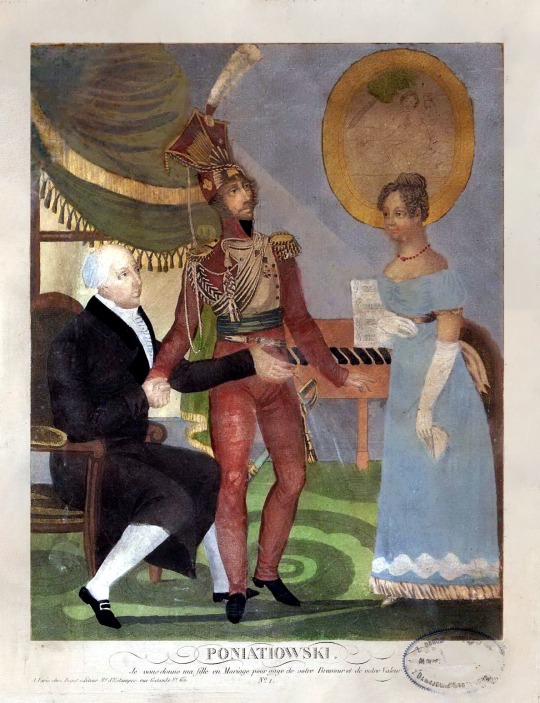
Prince Józef making a proposal, an engraving by F. Begat, 1821, from a French aquatint series illustrating Poniatowski’s life and death events - a completely imaginary, but the best illustration combining both the topics of “Poniatowski” and “marriage” I was able to find.
And to understand why Pepi remained a bachelor to the end of his days we need to have a look at his whole life, starting from the younger years.
Because when prince Poniatowski was in his twenties he did want to marry, to make his first love, the Austrian countess Karolina von Thun, his wedded wife.

Maria Carolina Anna von Thun, miniature brush by Anna Hochstädt (based on the original by Friedrich Heinrich Füger).
But, as I wrote in the post dedicated to prince Józef’s women, Pepi’s uncle, the Polish king, didn’t allow the nephew to associate himself with a girl of his choice. So, in the first case Poniatowski didn’t marry because he was prohibited to.
Furthermore, the king had his own ideas on which families it would have been convenient to become related with ordering prince Józef’s hands to their daughters. Among them there were a couple of cousins Czartoryskis (Maria and her younger sister, Zofia). Then Krystyna - the daughter of Ignacy Potocki. And one more girl - from Rzewuski family etc. (But all these projects remained on paper, and I am not even sure whether Józef knew about them.)
Anyway, the pressing of necessity to obey his uncle-king in matrimonial matters remained with prince Józef at least until Stanisław’s August abdication in 1795 (if not till 1798, when the latter died). And Pepi was finally “free” his first love wasn’t free anymore.

Élisabeth Vigée Le Brun, portrait of Lady Gillford, nee Marie Caroline von Thun, ci. 1792-95.
Yes, in 1793 the countess von Thun became the wife of a British diplomat, lord Gillford.
And approximately at the same time in Pepi’s life there appeared another lady, a Frenchwoman named Henriette de Vauban.

Felicja Pichor-Śliwicka as Henriette de Vauban and Józef Węgrzyn as Józef Poniatowski in Jan Adolf Hertz’s play “Prince Jozef Poniatowski”
First she accompanied prince Józef and his sister during their travel around Europe. And later, when in 1798 Poniatowski settled down in Warsaw, Madame de Vauban not only moved together with him into his famous palace “Pod Blachą” but quickly took on herself responsibilities of the “hostess”.

An unknown painter, a miniature portrait of Henriette de Vauban, ci. 1789
And the presence of Henriette in prince Józef’s life is thought by French (and even some Polish) historians to be a reason of Poniatowski’s indisposition to “tie the knot”.
Yes, being from 1798 to 1806 a Prussian subject and a private person Poniatowski theoretically could propose whoever he wanted. But Madame de Vauban was, from one hand, already married. And, from the other hand, she was giving prince Józef enough comfort not to seek consolation in a marriage with another woman.
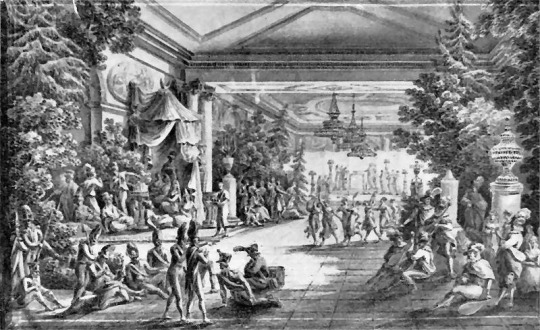
The feast arranged on occasion of prince Jozef’s birthday in the former royal library at the castle in Warsaw, Zygmunt Vogel, 1808
So it may be stated that prince Józef didn’t marry Madame de Vauban because she wasn’t eligible, and didn’t choose any other woman because he didn’t want to.
Ok, you may ask, and what about Zofia Czosnowska, the woman who gave birth to Poniatowski’s second son?
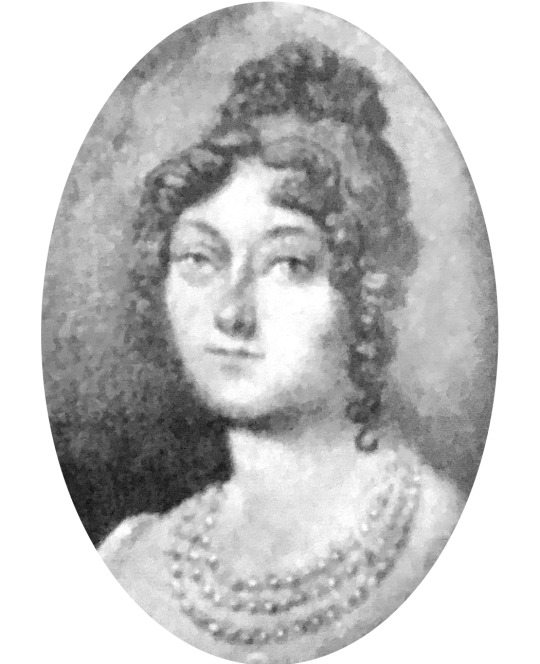
An unknown painter, a miniature portrait of Zofia Czosnowska
Considering this lady we first need to keep in mind that she herself was also married. (And though she separated from her first husband even before she became Pepi’s mistress, their formal divorce happened much after Poniatowski’s death, she during the time of his life Zofia Czosnowska wasn’t free either.)
An aside I couldn’t help but write: with all Pepi’s feelings towards beautiful Zofia, her appearance in his life didn’t change prince Józef’s lifestyle. As if nothing had happened Henriette de Vauban continued to live in Poniatowski’s house, prince Józef mentioned her in his will of 1812, and even shortly before his death he is recalled to say that “When it comes to dying ... to the afterlife I will take with me the unearthly smile of Henrietta ...”. All this IMHO eloquently says whom he really was attached to.
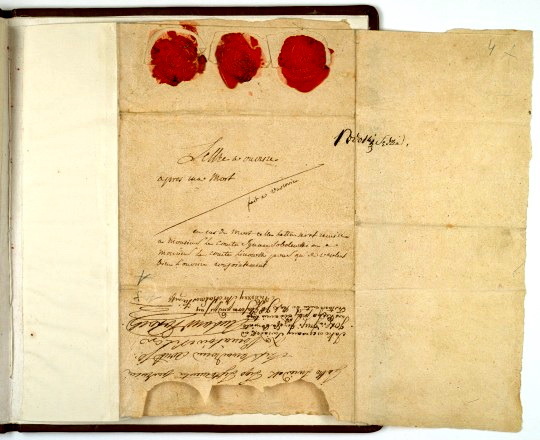
Poniatowski’s will
And there is one more thing we should take into account when looking at prince Józef’s later years. Namely - the creation in 1807 the Duchy of Warsaw.

Napoleon issuing the Constitution of the Duchy of Warsaw by Marcello Bacciarelli (1811)
Because this event, definitely positive for prince Józef’s motherland, simultaneously turned him from a private person to a public one, with all the consequences. And though Napoleonic code, from one hand, allowed divorces, the emperor, on the other hand, preferred to arrange marriages to his people by himself. Which means that had prince Józef acquired a desire to marry a woman he liked he first should have persuaded Napoleon to approve such a choice. And this again put Poniatowski in a kinda gloomy state like it had been years ago when he was dependent on the wishes of his monarch. And this fact may in my opinion served an explanation if to ask why Pepi didn’t divorce one of his mistresses from her husband and marry her...
And the last but not the least. Yes, by many people prince Józef is thought to have be a womanizer, but the more I learn about him the am I becoming convinced, that this might been a kind of “exaggeration”.
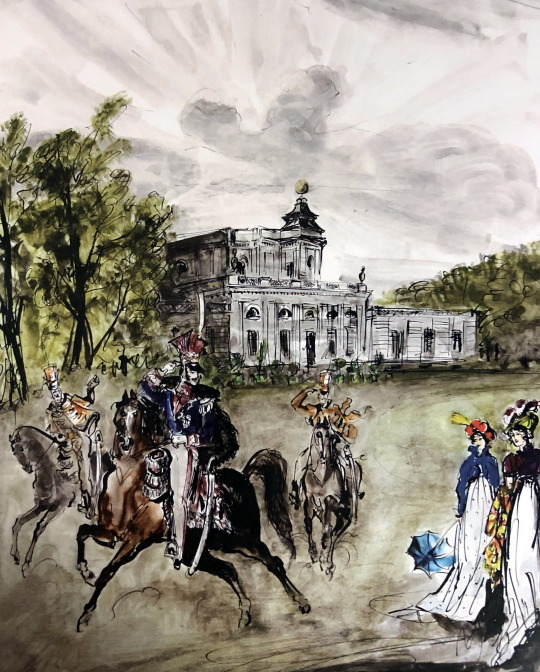
Antoni Uniechowski, prince Józef Poniatowski in Jabłonna, 1975
Because many a diarists recall that “he liked women, and women liked him”, but precise names are rarely mentioned, and if to count the ones of Poniatowski’s proven “love interests” the number is in fact not very high (especially to compare with such known “ladies' man” from the epoch like Napoleon, Talleyrand, Murat etc..)
#Poniatowski#józef poniatowski#józef poniatowski’s women#henriette de vauban#zofia czosnowska#karolina von thun
14 notes
·
View notes
Text
Józef Poniatowski’s family album.
Part II. Grandparents, uncles, cousins (or 3 Stanisławs, 2 Konstncjas, Kazimierz and Michał )))
This week let’s continue talking about prince Józef relatives. In the previous post on the topic I wrote (and showed portraits) of Pepi’s parents and sister. So today there will be images and some information about others.
Let’s start with the grandparents. (Unfortunately, I wasn’t able to find much about Poniatowski’s maternal ancestors, so this post will be about relatives from his father's side...)
This fancy gentleman is the father of prince Anrdzej and the progenitor of the family - Stanisław Poniatowski.
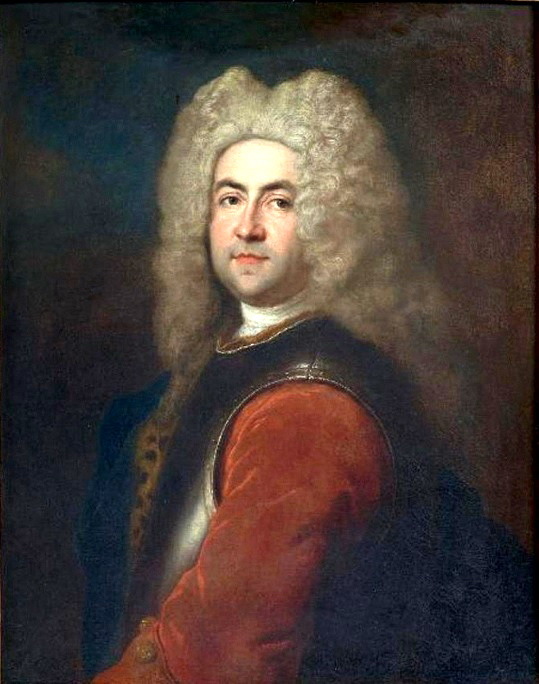
Portrait of Stanisław Poniatowski, unknown painter, 18th century
He was born in 1676, as a son of a petty nobleman from Lesser Poland. And died in 1762, having achieved the highest rank possible for a civil servants in the Polish-Lithuanian commonwealth - the castellan of Kraków. (Speaking in modern terms Stanisław Poniatowski can be called a self-made man.)
Of course, the life of such a man was full of ups and downs. That is why telling you about him I would like to focus only on things, which IMHO had some similarities with the destiny of Stanisłasw’s grandson, prince Józef.
During the Great Northern War Stanisław took the side of the Swedish king Charles XII and the latter’s protégé - as a king of Poland - Stanisław Leszczyński. (On the other side there were Peter The First of Russia and August II of Saxony, who had been elected as a Polish king.)
To the misfortune of the first party, one of the decisive battles of that war, the one Poltava in 1709, was lost, but this wasn’t a reason for Poniatowski to turn his back on Charles. On the contrary, Stanisław then saved life of his suzerain, and after that help him to flee to Turkey. And remained faithful the Swedidh king to the very end, till Charles’ death 10 years later. (Although for this reason Stanisław had to spend all these years abroad, taking care of various matters of the latter.)
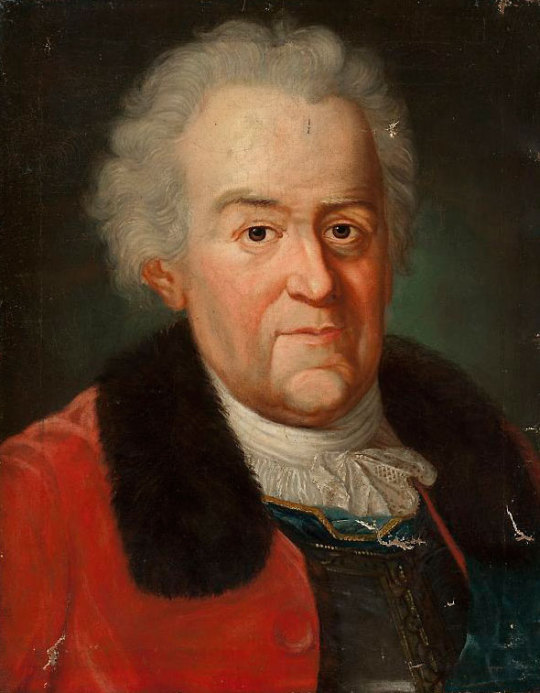
Marcello Bacciarelli, Portrait of Stanisław Poniatowski, after 1758, National Museum in Warsaw
And only after Charles passing away, Poniatowski went to Poland and asked pardon from August II. And having received it, remaining a faithful servant of that ruler till the Saxon king’s death in 1732.
During the next interregnum, however, Stanisław supported again the candidacy of Stanisław Leszczyński, the former protégé of Charles II. And only under the pressure of circumstances (one of his youngest sons, his namesake Stanisław, the future last king of Poland, was kidnapped by the adversaries of the opposite, Saxon party, to forced Poniatowski to join them) he switched sides.
As for Stanisław’s private life - it was also not without complications. In 1710 he married Teresa Jasieniecka, a widow of a Lithuanian nobleman Ogiński. But shortly the wedding it turned out that Teresa’s financial state was not so well as expected, instead of money she possessed debts only. And it looks like it was the reason for Poniatowski to leave her. (Some sources even say that the couple eventually divorced).
Anyway, whatever happened with Teresa later, in 1720 Stanisław seemed to be eligible again, because that very year he married again, this time to Konstancja Czartoryska.
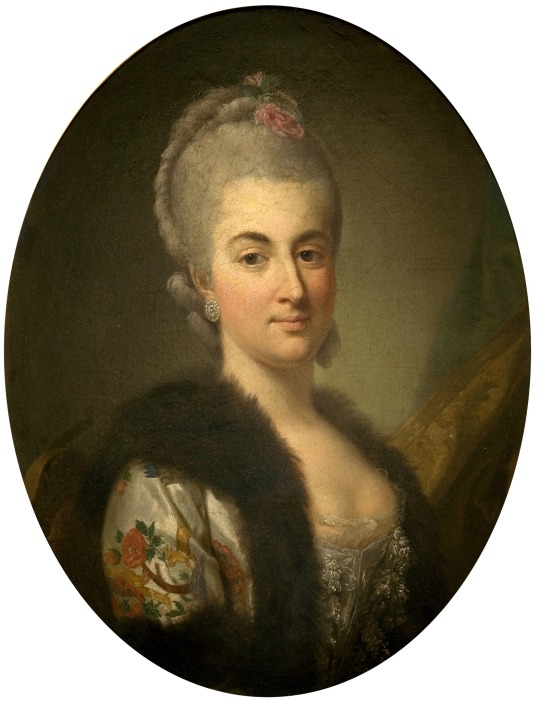
Per Krafft the Elder: Portrait of Konstancja Czartoryska, circa 1768, National Museum Kraków
Being born circa 1700 Konstancja was about 20-25 years younger than Stanisław’s, but this didn’t prevent the the marriage from being successful. The reason might have been that, though for Poniatowski this was again a kinda “strategic marriage” (because the Czartoryski family was very powerful), the bride was really in love with her groom. To such an extent that she married him despite her father’s will.

Marcello Bacciarelli, Portrait of Konstancja Czartoryska, 18th century
And, in general, Konstancja was so stubborn and willful, that in the family she was called “Chmura gradowa” (hail cloud).
As an example of her adherence to principles there might be recalled the story of her son Kazimierz duel with Adam Tarło. First she forced Kazimierz to challenge Tarło - though even by the standards of that time the reason doesn’t seem justified enough. An then, when the shooting happened with no harm to both sides and young men reconciled, the mother made the son to challenge his former adversary twice. And that time the duel ended with a death, fortunately to her - not of her son.
And such a story was not a unique one. (And something prompts me that had Konstancja been alive in 1761, when her son Andrzej, prince Józef’s future father, was about to marry a Czech noblewoman Teresa Kinska, the princess Poniatowska might not have agreed to that union. But the latter died already in 1758, so it wasn’t hard for Andrzej to get agreement from his very old and ailing father...)
Now, let us move to the next generation of Poniatowskis. The most known of them (and who, btw, was the favorite son of his mother) is Stanisław Antoni. Because in 1763 he was elected to become the king of the Polish-Lithuanian commonwealth (and, ascending the throne, changed his second name to “August”).
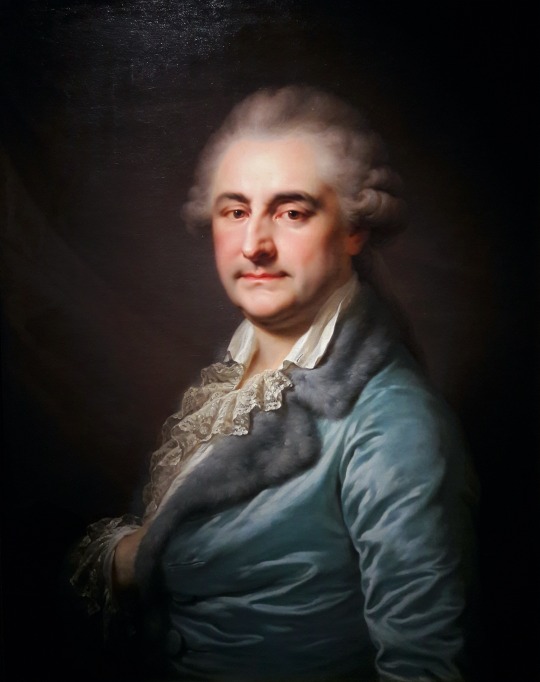
Johann Baptist von Lampi the Elder: Portrait of Stanislaus Augustus in a dressing-gown, between 1788 and 1789, National Museum in Warsaw
Do you remember that the second name of prince Józef was “Antoni”? Yes, he got it in honor of that uncle of his!
And later Stanisław August had a lot of influence on his nephew, taking care on young Pepi and his older sister Teresa after their father’s death in 1773.
But in my opinion it won’t be correct to call prince Józef the favorite of king Stanisław, the person whom the latter saw as his possible successor on the Polish throne. Why? Because there also was the oldest of Stanisław’s siblings children, the son of the above mentioned Kazimierz and the king’s namesake - one more Stanisław. (More about him - a little bit below.) And only for the short period from 1791, when that Stanisław withdrew from public life and emigrated to Italy, till 1795 Pepi’s candidature might have seriously been seemed as a possible royal successor.
Ok, now let’s look at Kazimierz. In addition to participating in that infamous duel the oldest of survived sons of the Poniatowskis was known for leading a rather riotous life. Having married a wealthy bride Apolonia Ustrzycka he had a lot of money and spent them freely and sometimes rather eccentrically. In his greenhouses, for example, there were grown... pineapples! And he also brought to Poland from Africa a bunch of monkeys (though all they died shortly because of the cold Polish climate (( )
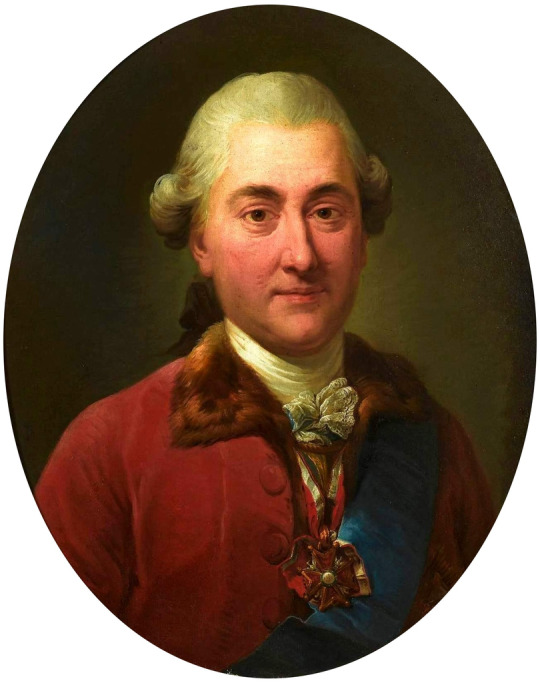
Unidentified painter, Portrait of Kazimierz Poniatowski, second half of 18th century, Palace Museum in Wilanów
In his private life prince Kazimierz was also a real child of his time - he had several mistresses. And one of them he even drove around Warsaw naked - so that everyone could "see" her charms. (You see, prince Józef had people among his uncles to take examples from ))) And I must also mention, that Kazimierz had a loving affection for his nephew. And in the last decade of the 18th century, when Pepi was already living in Warsaw, the uncle willingly invited the nephew to his place and even supported him financially.
And despite that notorious style of life prince Kazimierz outlived all his younger brothers and died in 1800, being almost 80 years old.
And now a little bit information about Michał, the youngest of prince Józef uncles. He was destined by his parents for the clergy, and in the church hierarchy he “climbed” to the highest Polish rank - the Primate of Poland. (Though, as many sources state, prince Michal was a priest just in the spirit of his age - having mistresses and possible even illegitimate children.)

Marcello Bacciarelli, Portret of Michał Jerzy Poniatowski, National Museum in Poznań, 18th century
And the circumstances of his death in 1794, in the age of 57 years only, still aren’t clear enough. That was the time, as you may remember, of Kościuszko’s Uprising, and Michał was among supporters of the king and the latter’s pro-Russian politics. So, when the primate became seriosly ill and then died there appeared rumors, that that might have been a suicide, in fear for being hanged, as those members of Targowica Confederation who weren’t lucky to flee.
In relation with prince Józef I can name only one significant thing of Michał’s biography - it was who from him Pepi inherited Jabłonna village under Warsaw with its famous palace.
For the record I should also mention that the Poniatowskis-senior had also 2 daughters, Ludwika Maria and Izabela, but they didn’t seem to play significant roles in their nephew’s life.
And now let’s look at the third generation - Pepi’s cousins, children of prince Kazimierz.
This is the very prince Stanisław, whom I mentioned above:
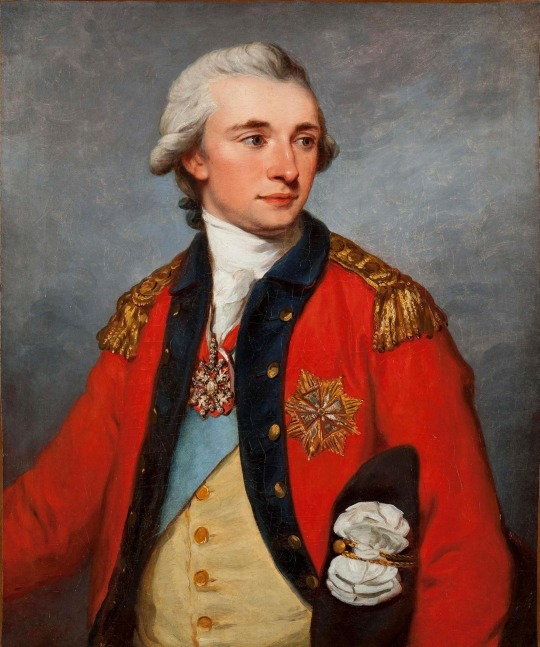
Angelica Kauffman, Portrait of Stanisław Poniatowski (1754-1833), 1786
Very well educated and economically talented, he carried out a lot of reforms in his vast estates in Ukraine, and made these land prosper. Being interested in art, he founded a painting school in Warsaw. More than once a member of the Sejm, elected marshal of the knighthood of the Permanent Council, member of the confederation of the Four-Year Sejm and... not a popular figure among the the nobility (szlachta).
Because of the latter reason in 1790 there arose a conflict between prince Stanisław and his adversaries, after which the prince resigned from all his post and abroad.
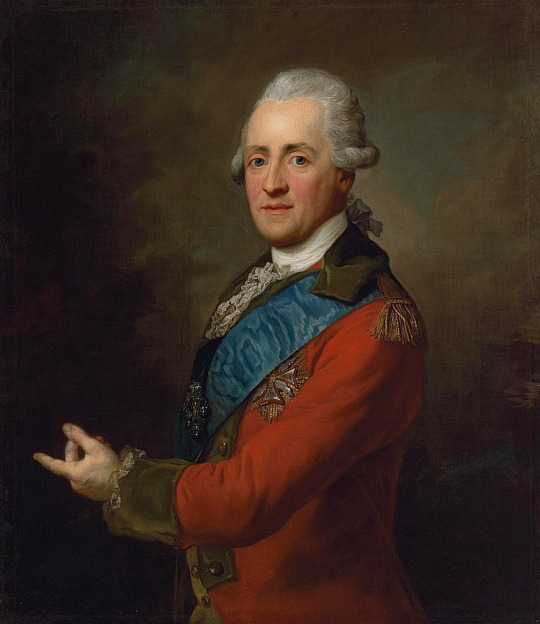
Portrait of Stanisław Poniatowski (1754–1833), attributed to Johann Baptist von Lampi the Elder, 18th century
He settled in Italy, where he owned estates, and unlike his cousin Józef, never returned to public life.
As for Stanisław’s private life - well, it also looked like a suitable plot for a romance novel. The prince met his future wife in Rome, when he was already in his fifties. She was thirty years younger than him and... a wife of his neighbor.
Her name was Cassandra Luci, and she was a common woman, beaten by her cruel husband. And one day, trying escape from an attack, she knocked on prince Poniatowski’s door, was allowed to enter his residence, and stayed with the latter forever.
First, of course, Cassandra served in Stanisław’s residence just as servant, becoming the housekeeper. But soon she answered his feelings, and... by 1816 the couple had already 5 children - 2 sons and 3 daughters. And when in 1830 Cassandra’s husband died, Stanisław was finally able to marry her.
And all the Poniatowskis living now in France are descendants of this couple. Or, to be more precise, of their second son Joseph Michael.
Relating to prince Józef - it looks like his cousin Stanisław didn’t have much affection on him. They met a couple of times before Pepi moved to Warsaw in 1788, definitely had chances to see each other between that time and the year when Stanisław emigrated, but that’s all. And much more close prince Józef was with his other “probably” cousins - the sons of king’s mistress, Elżbieta Grabowska. (But this definitely goes out the topic of this post.)
So, let’s move to the last person of today’s article, prince Stanisław’s younger sister princess Konstancja.
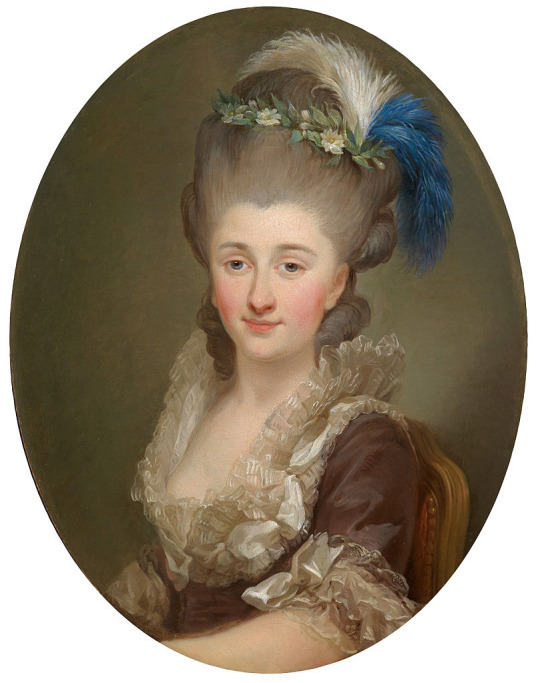
Marcello Bacciarelli, Portrait of Konstancja Tyszkiewicz, nee princess Poniatowska, circa 1775
And, I have to admit, she didn’t play any significant role in Pepi’s life either. (Though her daughter, Anetka, might have had - but about the latter I will write later, when the time comes to publish next post of prince Józef women.) But the reason I am writing about this Konstancja now is that her husband’s surname was Tyszkiewicz, just like the surname of the Pepi’s sister Teresa’s husband.
If you ask me whether those two Tyszkiewiczs were relative, I would answer you that they were very distant ones, because last common ancestor was the progenitor of the Tyszkiewicz family, named Tyszka, who lived in the 15th century.
As for why the king decided to marry both his nieces to the Tyszkiewicz family - on this question I don’t either have an answer. But I can quote you a verse which was written in Poland that time:
Tyszkiewicza
Król policzą
Między bliskich swoje
Dał jednemu
Dał drugiemu
Swych synowic dwoje
(Translation: The king counts the Tyszkiewiczs among his relatives, he gave to one of them and to another two of his nieces)
And because of these two Tyszkiewiczs, and the fact that Anetka Potocka née Tyszkiewicz is sometimes called prince Józef’s niece (though in fact they were first cousins once removed) Teresa Poniatowska, Pepi’s sister is, in these cases, called her mother, which is not at all true. And eery time I write such a statement it that makes me cringe. That is why I felt I ought to write about Konstancja, for the people know that there was one more Mrs. Tyszkiewicz, and that she was Anetka’s real mother.
Well, that’s all for today. and I hope I didn’t make you much tires with untangling all these family ties? ))
#józef poniatowski#the poniatowskis#poniatowski#stanisław poniatowski#stanisław august poniatowski#polish history#konstancja poniatowska#kazimierz poniatowski#michał poniatowski
6 notes
·
View notes
Text
Portraits of prince Józef Poniatowski.
Part III - the rest of "big and colorful”
Ok, dear Tumblr friends, while I am here, let me continue the topic of prince Poniatowski’s portraits.
For those who have joined us just - a little “recap”. Previously I showed first portraits, for which Józef Poniatwoski might have sat, later then - his most known posthumous one (with copies).
Now the time came to show you the rest of oil paintings, depicting “the Polish Bayard”.
To start I would like with this image, which hangs in Poniatowski’s museum in the Copper-Roofed palace in Warsaw. I’ve seen this portrait with my own eyes and it also is among my favorite effigies of Pepi.

Franciszek Paderewski, portrait of Prince Joseph Poniatowski, 1814
As the most known Pepi’s portrait this one was as well popular enough to become a source of several copies.

The copy of unknown author, from the museum of Warsaw
And this one, though it looks a little bit different, is also considered to be a copy of Paderewski’s work:

Unknown painter (from Franciszek Paderewski;s original), portrait of Prince Joseph Poniatowski, The National Museum in Kraków
The next couple of images, though attributed to different painters, in my opinion also look like an original and a copy:

Portrait of Prince Józef Poniatowski, in uniform with a ribbon and the star of the Great Cross Virtuti Militari, attributed Józef Kosiński, circa around 1815-1820

Antoni Brodowski, Portrait of Prince Józef Poniatowski, around 1820
This one is the only one from the whole today’s set, to which prince Józef theoretically might have posed. Because here he has stars on the epaulets, not cannons. But I stumbled this image in a book, not in a museum, that is why I have doubts in the first place.

Marcello Bacciarelli (?) "Prince Joseph in the uniform of a Major General according regulations from 1810"
And the second thing causing my concerns is... that portrait, hanging in the palace of Jabłonna:

Unfortunately, I wasn’t able to obtain any detailed data on the topic of it, but imho prince’s face here copies the face from the above placed image in every detail. (Though the model’s pose, especially the hand on the saber, look like they are borrowed from Josef Grassi’s image.)))
And what do you think? I would be grateful if you share your thoughts on this (and the previous one) pair in comments!
But now let’s return to the portraits left. This one, as you may remember, I “discovered” with your help, my dear friends:

Portrait of Prince Józef Poniatowski by unknown painter painter of Viennese school, 18th / 19th century
And later I was able to see it with my own eyes, hanging in The Pan Tadeusz Museum (“Muzeum Pana Tadeusza”) in Wrocław:

The portrait is dated there as painted in 18-19th century, but seeing cannons on the epaulets, I assume it also must have been created after 1813.
And as the last one from the “big and colorful” images of prince Józef I decided to place the work of a representative of the famous Polish painters dynasty, the Kossaks:

Juliusz Kossak, Portrait of Prince Józef on horseback, 1879
The images is exposed in the Łańcut castle (and I have not seen it yet...), but even from a photocopy it looks very impressive! That is why I decided to finish this set with it.
#poniatiwski#józef poniatowski#józef poniatowski’s portraits#Franciszek Paderewski#Józef Kosiński#Antoni Brodowski#Marcello Bacciarelli#Juliusz Kossak
4 notes
·
View notes
Photo

0364.1 -- .3, 2020-01-05 15:20 -- 15:32, Apple iPhone 7, Apple iPhone 7 built-in back wide lens, Moment Pro camera, RAW, Adobe LightRoom, InstaSize, Shot on-the-go, Observed scene. Park, Zespół pałacowo-parkowy w Jabłonnie (at Jabłonna Palace) https://www.instagram.com/p/CZFW0P2o2xu/?utm_medium=tumblr
0 notes
Photo

w: Jabłonna Palace https://www.instagram.com/p/BryCwMoF9GwDbxy9_Ba7RgCBqLqa-CBFE3nNN80/?utm_source=ig_tumblr_share&igshid=cuf8xodih2z5
0 notes
Photo

w: Jabłonna Palace https://www.instagram.com/p/BpulacNFm83S2g3Ca-leIoOwgPoJs-FyTJOVUw0/?utm_source=ig_tumblr_share&igshid=u9eh3eoc614j
0 notes